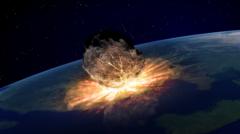The article text:
A recently published study unveils the dramatic consequences of a mega meteorite strike that occurred over three billion years ago, vastly exceeding the historical impacts familiar to us today. The meteorite, dubbed S2, was remarkably 40-60 kilometers in diameter, a staggering size comparing to the infamous asteroid that led to the extinction of the dinosaurs, which was about 10 kilometers wide.
The S2 meteorite struck Earth when it was still in its infancy, transforming a primordial landscape largely covered by oceans and a few emerging landmasses. The powerful collision created a crater measuring 500 kilometers across, sending an immense amount of energy across the planet. As scientists recount, this event unleashed a tsunami more catastrophic than any in recorded history, surpassing the ferocity of the 2004 Indian Ocean tsunami.
To evaluate the immediate aftermath and residual effects of this impact, researchers including lead author Prof. Nadja Drabon from Harvard University undertook an arduous expedition to the Eastern Barberton Greenstone Belt in South Africa, a site recognized for harboring some of Earth’s oldest rocks. Equipped with sledgehammers, the team meticulously collected rock samples while navigating the natural hazards of the region, including wild animals and poaching threats.
What they discovered was unexpected: Instead of merely causing devastation, the disaster may have played a pivotal role in nurturing early life. While the meteorite collision obliterated a vast amount of existing life—with oceans turning into boiling expanses and skies filled with dark clouds—the research indicated that violent upheavals churned up vital nutrients like phosphorus and iron, which became essential for the burgeoning microbial communities.
"When you consider life, it shows remarkable resilience," notes Prof. Drabon. “Much like bacteria that can multiply rapidly after being nearly eradicated, life on Earth rebounded strongly from the wreckage of this impact.” The introduction of these nutrients likely provided a surge of energy to simple organisms, facilitating an environment ripe for growth.
As they piece together this cosmic puzzle, researchers are beginning to view asteroid impacts not solely as catastrophic events but as pivotal moments that may have fueled the evolutionary processes that led to life's diversification on our planet. Their findings challenge traditional perceptions of disaster, transforming it into a narrative of resurgence and regeneration in the cosmic timeline.
The essential results and implications of this study are documented in the journal PNAS, shedding light on the complex relationship between life’s evolution and the catastrophic events of Earth’s early history.
A recently published study unveils the dramatic consequences of a mega meteorite strike that occurred over three billion years ago, vastly exceeding the historical impacts familiar to us today. The meteorite, dubbed S2, was remarkably 40-60 kilometers in diameter, a staggering size comparing to the infamous asteroid that led to the extinction of the dinosaurs, which was about 10 kilometers wide.
The S2 meteorite struck Earth when it was still in its infancy, transforming a primordial landscape largely covered by oceans and a few emerging landmasses. The powerful collision created a crater measuring 500 kilometers across, sending an immense amount of energy across the planet. As scientists recount, this event unleashed a tsunami more catastrophic than any in recorded history, surpassing the ferocity of the 2004 Indian Ocean tsunami.
To evaluate the immediate aftermath and residual effects of this impact, researchers including lead author Prof. Nadja Drabon from Harvard University undertook an arduous expedition to the Eastern Barberton Greenstone Belt in South Africa, a site recognized for harboring some of Earth’s oldest rocks. Equipped with sledgehammers, the team meticulously collected rock samples while navigating the natural hazards of the region, including wild animals and poaching threats.
What they discovered was unexpected: Instead of merely causing devastation, the disaster may have played a pivotal role in nurturing early life. While the meteorite collision obliterated a vast amount of existing life—with oceans turning into boiling expanses and skies filled with dark clouds—the research indicated that violent upheavals churned up vital nutrients like phosphorus and iron, which became essential for the burgeoning microbial communities.
"When you consider life, it shows remarkable resilience," notes Prof. Drabon. “Much like bacteria that can multiply rapidly after being nearly eradicated, life on Earth rebounded strongly from the wreckage of this impact.” The introduction of these nutrients likely provided a surge of energy to simple organisms, facilitating an environment ripe for growth.
As they piece together this cosmic puzzle, researchers are beginning to view asteroid impacts not solely as catastrophic events but as pivotal moments that may have fueled the evolutionary processes that led to life's diversification on our planet. Their findings challenge traditional perceptions of disaster, transforming it into a narrative of resurgence and regeneration in the cosmic timeline.
The essential results and implications of this study are documented in the journal PNAS, shedding light on the complex relationship between life’s evolution and the catastrophic events of Earth’s early history.

















